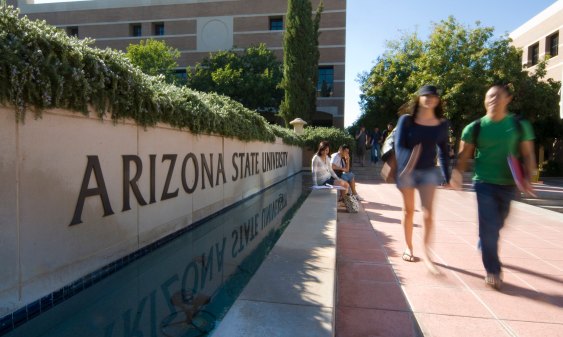Arizona State launches Zoom Innovation Lab

Arizona State University on Thursday opened its new Zoom Innovation Lab, a physical space where students can gather and create new tools for use with the eponymous video-conferencing platform.
The lab, located on Arizona State’s Tempe campus, is equipped with a green-screen room and recording studio, in addition to other collaboration spaces. Lev Gonick, chief information officer of ASU Public Enterprise, described the space’s location on campus as similar to a “store-front on Main Street” with its prime location hopefully encouraging students from across all disciplines to come in and experiment.
Arizona State has long been a Zoom customer, and was one of a handful of large research institutions to have an enterprise contract with the company before COVID-19. Over the new five-year partnership, the university will work directly with Zoom to develop learning opportunities for students that will prepare them jobs with the company, Gonick said.
For Zoom, the partnership is an opportunity to create a new talent pipeline, said Pat La Morte, the company’s global education solutions lead.
Projects undertaken in the Zoom Innovation Lab will be led by ASU students, with guidance from Zoom and its technology partners. La Morte said Zoom is providing a software development kit that will enable students to take a closer look at the video platform’s underlying code.
ASU students have already started integrating Zoom into a telehealth app developed by ASU’s Luminosity Lab. Working with Phoenix Children’s Hospital, student industrial designers and software developers are creating an app that will give doctors the ability to connect virtually with patients in their hospital rooms.
Rooms at Phoenix Children’s are equipped with Amazon Fire TV sets. By adding a camera, physicians and nurses will be able to use the Zoom-enabled app to carry out their rounds virtually.
The ASU Enterprise Technology Learning Futures Team has also built a virtual campus that students can explore using VR headsets. The students have avatars, which can click on an object in the virtual campus, such as a projector screen, to start or join a Zoom call. Users appear on the Zoom call as their avatars, but will be able to see people who are using Zoom from a physical terminal.
Gonick said it could eventually become possible to hold virtual campus tours, careers fairs and other events, with everyone sharing a virtual space. He also said students won’t necessarily need a headset to interact with what he called the “ASUniverse” — they’ll be able to call in from the real world and view the virtual campus.
On Friday, 125 students from various departments will head to the Zoom lab to contribute ideas and code to the “ASUniverse” project, Gonick said.
In time, Arizona State hopes to integrate Zoom into its campus app, making it easier for students to connect with faculty, staff and their peers, Gonick said. The university may also help develop instructional materials which could be shared with other institutions that partner with Zoom.




